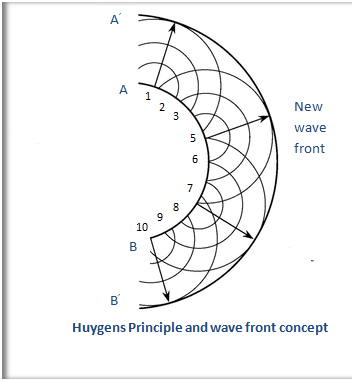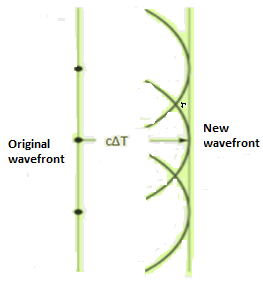Question 4: State and explain Huygens Principle. What is the difference between spherical and plane wave fronts?
ANSWER
Huygens Principle
If we know the shape (for example,amplitude, wavelength etc.) and location of a wave front at some instant of time ‘t’ we can find the shape and location of the new wave front after an interval of time ΔT with the help of Huygens principle. The principle consists of two parts;

- Every point of a wave front may be considered as a source of secondary wavelets (wavelets means small waves like a booklet means a small book) which spread out in the forward direction with the speed equal to the speed of propagation of the wave.
- The new position of the wavefront after a time ΔT can be found by drawing a plane tangential to all the secondary wavelets.
Consider the figure. Source ‘S’ emits waves and AB is the wavefront at some instant of time ’t’. We want to determine the shape and location of the new wave front after time interval ΔT. So take several points 1, 2, 3 … 10 on the wavefront AB and apply Huygens’s principle to them. Now these points are the sources of secondary wavelets. Draw a hemisphere (half sphere) of radius vΔT with centers at the selected points 1,2, 3… 10. Here ‘v’ is the speed of the wave.
Now according to the second part of the Huygens’s principle, we draw a surface A’B’ which is tangent to all the secondary wavelets. This surface A’B’ represents the new position of the wave.
Difference between spherical and plane wave fronts
When a wave passes through a medium, particles of the medium execute simple harmonic motion.
For example, when we drop a stone in a still (standing) pond of water, a series of circular waves move away from the point where the stone has hit the surface of water.
Spherical Wave front
The locus of all points in a medium which have the same phase is known as the wavefront. (Simply, the set of points at the same distance from the source).

However, in some other cases, we would be dealing with the waves traveling through space in three dimensions. So in such cases (for example, light) the wave fronts are concentric spheres (i-e, spheres having the same center and the source of light in this case is the center) originating from the source and traveling all over in three dimensions.
Spherical wave fronts are ones which are concentric spheres with its center at the source.
Plane wavefront
When this wavefront travels away from the source, at some far off distance its curvature (bend) decreases with time and a small portion of such wavefront seems as plane surface.
The straight portion of a spherical wavefront at large distance from the source is known as the plane wavefront.
Any feedback? … text on 03488519873

Pingback:interference-in-thin-films – msa
Pingback:interference-fringes-fringe-spacing – msa
Pingback:Comprehensive Questions, Physical Optics … msa – msa
Pingback:Physical Optics, Comprehensive Questions … msa – msa
Pingback:index-cq-ch9-p11 – msa